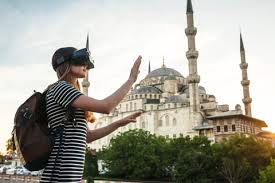Tourists: Embracing Technology for Seamless Travel Experiences
Embracing Technology in Travel
Tourists stand out wherever they go, whether they’re glued to their phones looking up a good dinner spot or following a maps app on the train, bus, or while walking. Being in a new place leaves us reliant on technology to help us get around – especially when we’re in a place where signs are written in languages we don’t know.
The Birth of Personalized Travel Assistant
What if there was a personalized assistant that works with users through multimodal AI, ensuring travelers never have to pull out their phones to check if they’re still moving in the right direction? Thanks to head-worn augmented reality (AR) and interactive, multimodal AI, the first-ever personalized travel assistant has been born. With roots in AR and a helping hand from generative AI, this personalized assistant allows users to communicate across multiple avenues.
The Case for Personalized Assistant in Travel
As AR’s quality improves and its broader implementation translates to lower costs, AR is becoming even more popular as a travel tool. Many operators in the travel industry are choosing to implement AR to enhance their services and accelerate appeal to clients, including:
Hospitality
Hospitality providers – hotels, hostels, inns, and more – use AR to help improve the personalization each client enjoys upon their arrival, whether that’s offering on-demand destination information or eliminating language barriers between foreign customers and those around them.
Tourism
ARM tourism tools significantly reduce operational and administrative costs. From digital docents to on-the-spot information about landmarks or buildings, these tools can drive bookings to on-site services and improve the overall guest experience.
Travel Agents
AR can open new revenue stream opportunities and improve consumer confidence by allowing customers to gain detailed insights before committing to a booking.
How Multimodal AI Creates the Personalized Travel Assistant
This personalized assistant is unlike any other in terms of capability or specification – especially compared to the technology tourists rely on today. Here are two key ways this technology is blazing new trails.
Vision and Display
The multimodal AI assistant is a one-stop shop able to visually generate images or web content, pull up the appropriate information for the user, read the options aloud, and translate them in another language if needed. Simply by pointing, the wearer can highlight things in the real world on the multimodal assistant’s display and get responses based on the questions they ask about the world around them.
These abilities make the personalized assistant perfect for travel due to the navigation and translation use cases. To ensure the optimal experience, AR glasses paired with the multimodal assistant should have a large field of view, high transparency, and a great resolution. All of these things will ensure wearers can fully engage with the world around them – that’s what travel is all about, and without seeing things in the real world, the AI assistant can’t engage with anything to provide help or meaningful insights that make it so special.
Generative Properties
For users with more in-depth questions or nuanced needs, the multimodal assistant can provide more in-depth responses to queries based on context or examples. Users can leverage this capability to get detailed recommendations for restaurants, shopping, events, tourist attractions, and more.
Similar to other chatbots, it can brainstorm ideas via text or images to provide answers to user questions like, “What are the locations this city is famous for, and what are some famous restaurants near those places?” This makes the assistant invaluable for travelers who like to plan their days ahead – and, inversely, those who would rather live in the moment while in a new place.
Privacy and Security Considerations
Like any new smart device, there are concerns about privacy and security safeguards during the implementation of the multimodal AI assistant. It is worth noting that there are certain protocols that could be harmful if user data is breached, from their payment information or shipping address to data about their personalized recommendations.
With AR, the stakes could be higher, as hackers able to breach the personalized assistant could gain access to what the user is doing, their location, preferences, and other private information.
Some Important Consumer Protection Notes:
- Be aware of what you’re asking of your personalized assistant. Anything you input into or create with any multimodal AI tool could be used to refine the AI further.
- Explore the settings. Multimodal AI comes with security and privacy controls consumers can use to ensure they’re comfortable with and consent to the use of their data and information.
- Be mindful of reality. While AR can be a powerful tool to augment the real world, users should always be aware of their real-world surroundings and look out for any differences between what their screen is showing them and what is actually around them.
Travel is an ideal use case for the multimodal AI assistant. With on-screen translation and navigation capabilities, the ability to engage with rich, unique cultures, and more, traveling to a new destination can become worlds easier. This tool is already being leveraged by the hospitality industry to streamline travel and boost engagement, and now has never been a better time to harness these cutting-edge personalized AR features.




